Referral-to-Treatment for Surgical Carpal Tunnel ... - 18 Weeks
Referral-to-Treatment for Surgical Carpal Tunnel ... - 18 Weeks
Referral-to-Treatment for Surgical Carpal Tunnel ... - 18 Weeks
Create successful ePaper yourself
Turn your PDF publications into a flip-book with our unique Google optimized e-Paper software.
<strong>Referral</strong>-<strong>to</strong>-<strong>Treatment</strong> <strong>for</strong> <strong>Surgical</strong> <strong>Carpal</strong> <strong>Tunnel</strong> Syndrome<br />
patients<br />
A Report from the Musculoskeletal Audit<br />
Interpretive text in blue from David Lawrie (Consultant Orthopaedic and Hand Surgeon, Aberdeen<br />
Royal Infirmary) and Tim Hems (Consultant Hand and Orthopaedic Surgeon, Greater Glasgow and<br />
Clyde)<br />
This report is the second in a series of sprint audit reports looking at different orthopaedic<br />
conditions from the Musculoskeletal Audit (MSk) and looks at referral <strong>to</strong> surgery data <strong>for</strong> patients<br />
undergoing surgery <strong>for</strong> <strong>Carpal</strong> <strong>Tunnel</strong> Syndrome (CTS).<br />
The carpal tunnel syndrome audit period ran <strong>for</strong> 14 weeks from 5th January <strong>to</strong> 9th April in all reported<br />
hospitals, and <strong>for</strong> up <strong>to</strong> twelve weeks be<strong>for</strong>e this in selected hospitals <strong>to</strong> increase sample sizes. We included<br />
all patients listed <strong>for</strong> an elective carpal tunnel release. MSk Local Audit Co-ordina<strong>to</strong>rs collected data from<br />
patient case notes, patient in<strong>for</strong>mation systems, results reporting and referral management systems.<br />
We are aware that many CTS patients are not treated surgically, and that pathways may differ<br />
between units. Here we only include CTS patients treated surgically, because such patients were<br />
readily identifiable at the point of treatment. However, we also identified all new CTS referrals during<br />
the audit period (January 5th <strong>to</strong> April 9th) <strong>for</strong> a subsequent audit later in the year which will also<br />
include non-surgical patients.<br />
This report is not intended <strong>to</strong> assess hospitals and waiting times, and does not take in<strong>to</strong> account ‘s<strong>to</strong>ps’<br />
that are beyond a hospital’s control (e.g. delays caused by patient preference). It is intended as a <strong>to</strong>ol <strong>for</strong><br />
management, <strong>to</strong> help managers and clinicians identify areas where <strong>Referral</strong> <strong>to</strong> <strong>Treatment</strong> delays are<br />
occurring and/or may be minimised.<br />
Executive Summary<br />
• <strong>Carpal</strong> tunnel is a common condition with up <strong>to</strong> 10% of the population having symp<strong>to</strong>ms<br />
• There are large variations in the waiting times and pathways <strong>for</strong> the management of carpal<br />
tunnel syndrome<br />
• The waiting times from referral <strong>to</strong> OPA and the surgical waiting times are similar between<br />
units<br />
• There are significant variations in the frequency and waiting times <strong>for</strong> preoperative Nerve<br />
Conduction Studies between centres<br />
• Some centres have major delays (of up <strong>to</strong> a year) accessing neurophysiology services<br />
Please send comments and queries <strong>to</strong> either<br />
Jane Campbell 01463 705850<br />
MSk Clinical Co-ordina<strong>to</strong>r jane.campbell7@nhs.net or<br />
Rik Smith 0131 275 7040<br />
MSk Senior Analyst<br />
rsmith11@nhs.net
Musculoskeletal Audit (MSk) - <strong>Carpal</strong> <strong>Tunnel</strong> Surgery<br />
How <strong>to</strong> use this report<br />
The <strong>Referral</strong> <strong>to</strong> <strong>Treatment</strong> period of surgical CTS patients is summarised on an individual hospital basis,<br />
firstly (A) <strong>for</strong> the whole period from <strong>Referral</strong> <strong>to</strong> <strong>Treatment</strong>, then in more detail <strong>for</strong> the constituent parts of<br />
this process:<br />
B <strong>Referral</strong> <strong>to</strong> Outpatient Appointment (OPA)<br />
C OPA <strong>to</strong> Diagnostics/Review<br />
D Diagnostics<br />
E Surgery<br />
Note that not all patients followed a conventional path from referral <strong>to</strong> outpatient appointment, subsequent<br />
diagnostics and review <strong>to</strong> surgery (e.g. patients could be referred in<strong>to</strong> the system <strong>to</strong> an NHS hospital from a<br />
private clinic). Also, some dates <strong>for</strong> various parts of the patient journey (particularly vetting and allocation<br />
dates) were not always available. This explains variation in sample sizes across the report.<br />
The <strong>18</strong>-week <strong>Referral</strong> <strong>to</strong> <strong>Treatment</strong> target does, of course, allow <strong>for</strong> clock-s<strong>to</strong>pping <strong>for</strong> circumstances<br />
beyond a hospital’s control. Allowing <strong>for</strong> all such patient-centred delays was beyond the remit of this audit,<br />
although some summary data are included. Inspection of the constituent parts of the patient referral-<strong>to</strong>surgery<br />
period should reveal the main limiting steps in each unit, but, if it would be useful, please ask us <strong>to</strong><br />
select or break down your in<strong>for</strong>mation further.<br />
During the audit period the Local Audit Co-ordina<strong>to</strong>rs achieved a near 100% inclusion rate of carpal tunnel<br />
release patients in most participating hospitals (Table 1). Almost all <strong>Carpal</strong> <strong>Tunnel</strong> surgery was carried out<br />
by the Orthopaedic specialty, except in StJohns/RIE (98% by Plastics) and ARI/Woodend (24% by<br />
Neurology/Neurosurgery).<br />
Table 1: Number of patients reported on<br />
Hospital Audit period *<br />
Number of surgical CTS<br />
patients identified in<br />
report period in each<br />
hospital<br />
Number of surgical<br />
CTS patients included<br />
in this report*<br />
Wishaw Oct 2009-Apr 2010 32 32<br />
GRI / S<strong>to</strong>bhill Oct 2009-Apr 2010 80 80<br />
DGRI / Garrick Oct 2009-Apr 2010 67 67<br />
QMH / Vic<strong>to</strong>ria Jan 2010-Apr 2010 101 101<br />
Elgin Nov 2009-Apr 2010 32 32<br />
Borders Oct 2009-Apr 2010 69 69<br />
Ninewells / Stracathro ** Jan 2010-Apr 2010 94 94<br />
RAH/VOL Nov 2009-Apr 2010 91 91<br />
ARI / Woodend Jan 2010-Apr 2010 91 90<br />
Perth Jan 2010-Apr 2010 25 25<br />
Monklands *** Oct 2009-Apr 2010 54 54<br />
Hairmyres Oct 2009-Apr 2010 107 107<br />
St Johns / RIE Jan 2010-Apr 2010 <strong>18</strong>7 178<br />
Raigmore Oct 2009-Apr 2010 73 71<br />
Inverclyde / Dunoon Oct 2009-Apr 2010 59 59<br />
Forth Valley Oct 2009-Apr 2010 68 68<br />
Total 1230 12<strong>18</strong><br />
* End of Audit period was 9th April 2010 <strong>for</strong> all hospitals<br />
** Includes 9 patients originating at Ninewells who were operated on at PRI<br />
*** Includes 5 patients originating at Monklands who were operated on at Hairmyres<br />
Patients sent <strong>to</strong> Golden Jubilee National Hospital <strong>for</strong> surgery between Oc<strong>to</strong>ber and 9th April (57 al<strong>to</strong>gether, including 43<br />
from Lothian HB and 9 from Dumfries and Galloway) are not included in Table 1 or in other sections of this report.<br />
Data from Ayrshire and Arran was less complete than <strong>for</strong> other hospitals and is not included in this report<br />
- - 2
A) Summary of overall period from <strong>Referral</strong> <strong>to</strong> <strong>Treatment</strong><br />
Musculoskeletal Audit (MSk) - <strong>Carpal</strong> <strong>Tunnel</strong> Surgery<br />
Although many patients are referred or diagnosed with bilateral carpal tunnel syndrome, the patient<br />
pathway (and consequently the length of time from referral <strong>to</strong> treatment) varies significantly between<br />
treatment <strong>for</strong> first and second procedures. Due <strong>to</strong> these differences, all data contained in parts A-E<br />
of this report pertain <strong>to</strong> the hand treated first, unless there was a considerable time gap be<strong>for</strong>e the<br />
second hand necessitating a completely independent diagnosis and treatment cycle. Second/subsequent<br />
procedures that followed on immediately after treatment of the first hand (15% of all carpal tunnel<br />
operations) are detailed separately in part F.<br />
Fig. 1: Length of time from referral <strong>to</strong> surgery - all patients<br />
Percentage of patients<br />
100<br />
80<br />
60<br />
40<br />
20<br />
0<br />
Wishaw<br />
GRI/S<strong>to</strong>bhill<br />
DGRI/Garrick<br />
QMH/Vic<strong>to</strong>ria<br />
Elgin<br />
Borders<br />
Ninewells/Stra<br />
RAH/VOL<br />
ARI/Woodend<br />
Perth<br />
Monklands<br />
Hairmyres<br />
St Johns/RIE<br />
Raigmore<br />
IRH/Dunoon<br />
Forth Valley<br />
All patients<br />
1 year Missing data<br />
Missing data occurred if referral date was not known, often from an unconventional source (e.g. referral from a review of<br />
another treatment, or straight <strong>to</strong> Nerve Conduction Studies or a private patient listed <strong>for</strong> surgery)<br />
Fig. 1 includes 273 (26%) patients who had indicated that they were unavailable at some stage between<br />
referral and surgery. If unavailable at some stage, documented unavailability averaged 45 days (median=32<br />
days), and 100 (10%) patients were known <strong>to</strong> be unavailable <strong>for</strong> more than six weeks.<br />
Only 11% of patients who had indicated that they were unavailable at some stage between referral and<br />
surgery were treated within <strong>18</strong> weeks, compared <strong>to</strong> 28% of patients who were available throughout. Fig. 2<br />
reports the percentage of patients who met the <strong>18</strong>-week <strong>Referral</strong> <strong>to</strong> <strong>Treatment</strong> target after excluding these<br />
unavailable patients.<br />
Fig. 2: Length of time from referral <strong>to</strong> surgery - excluding patients who were unavailable at some<br />
stage during this period<br />
Percentage of patients<br />
100<br />
80<br />
60<br />
40<br />
20<br />
0<br />
Wishaw<br />
GRI/S<strong>to</strong>bhill<br />
DGRI/Garrick<br />
QMH/Vic<strong>to</strong>ria<br />
Elgin<br />
Borders<br />
Ninewells/Stra<br />
RAH/VOL<br />
ARI/Woodend<br />
Perth<br />
Monklands<br />
Hairmyres<br />
St Johns/RIE<br />
Raigmore<br />
IRH/Dunoon<br />
Forth Valley<br />
All patients<br />
1 year Missing data<br />
- - 3
Musculoskeletal Audit (MSk) - <strong>Carpal</strong> <strong>Tunnel</strong> Surgery<br />
Al<strong>to</strong>gether 38% of all patients had some patient-centred delay (unavailability; cancelled OPA, review or<br />
surgery; did not attend OPA, review or surgery; declined appointment; medically unfit <strong>for</strong> theatre; Fig. 3).<br />
These patients <strong>to</strong>ok a median of 35 weeks from referral <strong>to</strong> surgery, compared <strong>to</strong> 22 weeks in patients with no<br />
documented patient-centred delay.<br />
Fig. 3: Percentage of patients with some documented patient-centred delay (see text <strong>for</strong> definition)<br />
Percentage of patients<br />
100<br />
80<br />
60<br />
40<br />
20<br />
0<br />
Wishaw<br />
GRI/S<strong>to</strong>bhill<br />
DGRI/Garrick<br />
QMH/Vic<strong>to</strong>ria<br />
Elgin<br />
Borders<br />
Ninewells/Stra<br />
RAH/VOL<br />
ARI/Woodend<br />
Perth<br />
Monklands<br />
Hairmyres<br />
St Johns/RIE<br />
Raigmore<br />
IRH/Dunoon<br />
Forth Valley<br />
All patients<br />
As with the arthroscopy report, Fig. 3 shows that a substantial number of patients fail <strong>to</strong> attend or elect <strong>to</strong> be<br />
“unavailable” at some point in the patient pathway and that unavailability rates continue <strong>to</strong> vary widely across<br />
the country.<br />
- - 4
Musculoskeletal Audit (MSk) - <strong>Carpal</strong> <strong>Tunnel</strong> Surgery<br />
Fig. 4: Average time spent in each stage of the <strong>Referral</strong> <strong>to</strong> <strong>Treatment</strong> process - all patients<br />
Mean number of weeks<br />
50<br />
40<br />
30<br />
20<br />
10<br />
0<br />
Wishaw<br />
GRI/S<strong>to</strong>bhill<br />
DGRI/Garrick<br />
QMH/Vic<strong>to</strong>ria<br />
Elgin<br />
Borders<br />
Ninewells/Stra<br />
RAH/VOL<br />
ARI/Woodend<br />
Perth<br />
Monklands<br />
Hairmyres<br />
St Johns/RIE<br />
Raigmore<br />
IRH/Dunoon<br />
Forth Valley<br />
All patients<br />
From referral <strong>to</strong> OPA<br />
Diag/review <strong>to</strong> theatre list<br />
OPA <strong>to</strong> diagnostics/review<br />
Theatre list <strong>to</strong> surgery<br />
NOTES<br />
• Times are means <strong>for</strong> each stage <strong>for</strong> patients whose data was available<br />
• Time from OPA <strong>to</strong> diagnostics/review is <strong>to</strong> the first review clinic, or the date the diagnostic (NCS) was per<strong>for</strong>med if the patient<br />
was reviewed by phone or letter<br />
• Time from diagnostics/review <strong>to</strong> the date the patient was added <strong>to</strong> the theatre list is time from first review, and may have<br />
included subsequent reviews/diagnostics<br />
• If patients were added <strong>to</strong> the theatre list at the initial OPA, and were not referred <strong>for</strong> diagnostics or a subsequent review<br />
(approximately half of all patients), OPA <strong>to</strong> diagnostics/review was included as 0 weeks (SO AVERAGE REFLECTS NUMBER<br />
WHO HAD NCS AS WELL AS AVERAGE WAIT OF THOSE WHO HAD NCS - SEE LAST BULLET), and diagnostics/review<br />
<strong>to</strong> theatre list as the time between the initial OPA and the date the patient was added <strong>to</strong> the theatre list.<br />
• A small number of patients had diagnostics/reviews after they were apparently added <strong>to</strong> the theatre list. These were excluded<br />
from calculation of time from diagnostics/review <strong>to</strong> theatre list<br />
• The ‘mean’ time <strong>for</strong> OPA <strong>to</strong> diagnostics/review includes many patients who were added <strong>to</strong> the waiting list <strong>for</strong> surgery at the<br />
initial OPA (i.e. time from OPA <strong>to</strong> diagnostics/review=0 weeks). There<strong>for</strong>e the actual distribution of times from OPA <strong>to</strong><br />
diagnostics/review is not reflected by the mean, and may be skewed by a small number of long waiting times, OR BY A<br />
LARGE NUMBER OF PATIENTS WHO WERE NOT SENT FOR NCS.<br />
Note that the above figure will not show patient preference delays. For example, some clinics/waiting lists<br />
may phone patients <strong>to</strong> offer a choice of dates <strong>for</strong> OPA or surgery, and the only data available <strong>to</strong> the MSk<br />
Audit was the date accepted.<br />
Note that the time spent waiting from referral <strong>to</strong> outpatient clinic and on the theatre waiting list is<br />
relatively similar between centres. However, there is significantly more variation between centres in<br />
time spent waiting <strong>for</strong> diagnostic investigations (Nerve Conduction Studies), and also the time taken<br />
from Diagnostics/Review <strong>to</strong> being placed on the surgical waiting list. The availability and waiting<br />
time <strong>for</strong> neurophysiology investigations will play a major fac<strong>to</strong>r in these differences. The use in some<br />
centres of one-s<strong>to</strong>p carpal tunnel clinics with on-site Nerve Conduction Studies will eliminate the<br />
wait from OPA <strong>to</strong> Diagnostics/Review.<br />
- - 5
Musculoskeletal Audit (MSk) - <strong>Carpal</strong> <strong>Tunnel</strong> Surgery<br />
B) <strong>Referral</strong> <strong>to</strong> Outpatient Appointment<br />
92% of 1021 patients with documented length of time from <strong>Referral</strong> <strong>to</strong> Outpatient Appointment were seen<br />
within 15 weeks (Fig. 5). However, a large proportion of patients waited <strong>for</strong> 10 <strong>to</strong> 15 weeks be<strong>for</strong>e their<br />
Outpatient Appointment, leaving little time in the proposed <strong>18</strong> week pathway <strong>for</strong> investigations<br />
and/or treatment <strong>to</strong> occur.<br />
Fig. 5: Length of time from <strong>Referral</strong> <strong>to</strong> Outpatient Appointment<br />
Percentage of patients<br />
100<br />
80<br />
60<br />
40<br />
20<br />
0<br />
Wishaw<br />
GRI/S<strong>to</strong>bhill<br />
DGRI/Garrick<br />
QMH/Vic<strong>to</strong>ria<br />
Elgin<br />
Borders<br />
Ninewells/Stra<br />
RAH/VOL<br />
ARI/Woodend<br />
Perth<br />
Monklands<br />
Hairmyres<br />
St Johns/RIE<br />
Raigmore<br />
IRH/Dunoon<br />
Forth Valley<br />
All patients<br />
15 weeks Missing data<br />
Fig. 5 includes all patients irrespective of any reason <strong>for</strong> delay, and reflects the 15-week target <strong>for</strong> referral <strong>to</strong> Outpatient<br />
Appointment in operation at the start of the audit period. Comparison against the 12-week target times which came in<strong>to</strong><br />
place in March 2010 are available on request<br />
Although it was usually possible <strong>to</strong> find out who vetted patients and the vetting outcome, in many hospitals<br />
first vetting date was often unavailable (Table 2). This may improve with the introduction of e-vetting in some<br />
sites, and recording of vetting dates by whichever method has increased from 42% during the arthroscopy<br />
audit <strong>to</strong> 61% during the CTS audit period. Amongst patients whose vetting times were known, 91% of<br />
patients were vetted within a week (Table 2).<br />
Table 2: Average time from <strong>Referral</strong> <strong>to</strong> First Vetting<br />
% of patients whose vetting<br />
dates was documented<br />
Number of patients<br />
documented<br />
<strong>Referral</strong> <strong>to</strong> vetting<br />
Mean<br />
(weeks)<br />
% > 1<br />
week<br />
Wishaw 0% 0 - -<br />
GRI/S<strong>to</strong>bhill 92% 60 0.0 0%<br />
DGRI/Garrick 100% 64 0.0 0%<br />
QMH/Vic<strong>to</strong>ria 65% 51 1.4 53%<br />
Elgin 21% 5 0.0 0%<br />
Borders 96% 55 0.0 0%<br />
Ninewells/Stracathro 28% 22 0.4 5%<br />
RAH/VOL 28% 20 1.2 50%<br />
ARI/Woodend 7% 4 * *<br />
Perth 89% 17 0.2 0%<br />
Monklands 78% 31 0.9 19%<br />
Hairmyres 21% 19 0.8 16%<br />
St Johns/RIE 96% 146 0.1 1%<br />
Raigmore 89% 55 0.1 0%<br />
Inverclyde/Dunoon 66% 31 0.6 0%<br />
Forth Valley 37% 20 0.7 15%<br />
All patients 61% 600 0.3 9%<br />
* Data omitted if based on fewer than 5 patients<br />
- - 6
Musculoskeletal Audit (MSk) - <strong>Carpal</strong> <strong>Tunnel</strong> Surgery<br />
Hospital vetting policies vary considerably (Fig. 6). Fig. 6 also highlights the ongoing problem of poor<br />
documentation of the vetting process in some sites. If known, almost all patients originally vetted by<br />
clerical staff were subsequently vetted by medical staff. The overall time from referral <strong>to</strong> surgery was<br />
shorter if patients were first vetted by medical staff compared <strong>to</strong> ESPs or clerical staff (median 21 weeks<br />
compared <strong>to</strong> 29 or 33 weeks). When known, 83% of patients who were vetted twice were second-vetted<br />
within a week.<br />
Fig. 6: Who first vetted patients post <strong>Referral</strong><br />
100<br />
80<br />
60<br />
40<br />
20<br />
0<br />
Wishaw<br />
GRI/S<strong>to</strong>bhill<br />
DGRI/Garrick<br />
QMH/Vic<strong>to</strong>ria<br />
Elgin<br />
Borders<br />
Ninewells/Stra<br />
RAH/VOL<br />
ARI/Woodend<br />
Perth<br />
Monklands<br />
Hairmyres<br />
St Johns/RIE<br />
Raigmore<br />
IRH/Dunoon<br />
Forth Valley<br />
All patients<br />
Percentage of patients<br />
Medical staff ESP Clerical staff Not vetted Missing data<br />
53% of patients who were not vetted were unscheduled referrals (e.g. from ED). Others included patients going on <strong>to</strong><br />
have <strong>Carpal</strong> <strong>Tunnel</strong> surgery following referrals or reviews <strong>for</strong> other procedures.<br />
As expected, much of the time elapsed between <strong>Referral</strong> and Outpatient Appointment occurred whilst the<br />
patient awaited their offered OPA date. The average wait from the date the OPA was ready <strong>for</strong> allocation <strong>to</strong><br />
the date offered <strong>for</strong> OPA was 7.8 weeks, but many hospitals had a considerable proportion of patients who<br />
waited more than eight weeks (Table 3).<br />
Table 3: Average times from Vetting <strong>to</strong> Outpatient Appointment<br />
Vetting <strong>to</strong> Ready <strong>for</strong><br />
Allocation<br />
N<br />
Mean<br />
(weeks<br />
)<br />
% > 8<br />
week<br />
s<br />
N<br />
Allocation <strong>to</strong> Date<br />
Offered<br />
Mean<br />
(weeks)<br />
% > 8<br />
weeks<br />
Date Offered <strong>to</strong> OPA<br />
attendance<br />
N<br />
Mean<br />
(weeks<br />
)<br />
% > 8<br />
week<br />
s<br />
Wishaw 0 - - 26 10.9 92% 27 0.0 0%<br />
GRI/S<strong>to</strong>bhill 59 0.3 0% 65 10.8 75% 66 1.7 5%<br />
DGRI/Garrick 64 0.6 0% 65 7.3 51% 65 0.1 0%<br />
QMH/Vic<strong>to</strong>ria 50 5.1 10% 78 3.9 5% 79 0.3 0%<br />
Elgin 6 0.0 0% 25 7.6 36% 26 0.5 4%<br />
Borders 55 0.0 0% 59 8.9 61% 62 0.9 3%<br />
Ninewells/Stracathro 22 2.3 5% 76 4.0 3% 84 0.4 1%<br />
RAH/VOL 20 0.4 0% 75 7.2 48% 80 0.5 0%<br />
ARI/Woodend 2 * * 43 6.0 9% 66 0.4 2%<br />
Perth 17 0.3 0% 17 10.9 76% <strong>18</strong> 0.6 0%<br />
Monklands 31 0.0 0% 42 10.5 86% 42 0.7 2%<br />
Hairmyres 19 0.0 0% 99 10.1 82% 100 0.5 4%<br />
St Johns/RIE 144 2.3 5% 145 8.8 77% 148 0.6 3%<br />
Raigmore 56 0.1 0% 60 9.1 65% 61 0.4 0%<br />
Inverclyde/Dunoon 31 3.6 3% 42 4.2 2% 46 0.8 2%<br />
Forth Valley 20 0.0 0% 44 7.4 39% 54 0.1 0%<br />
All patients 596 1.4 2% 961 7.8 51% 1024 0.6 2%<br />
* Data omitted if based on fewer than 5 patients; sample sizes vary between columns due <strong>to</strong> availability of data<br />
- - 7
Musculoskeletal Audit (MSk) - <strong>Carpal</strong> <strong>Tunnel</strong> Surgery<br />
Nine per cent of OPAs were delayed because patients either Did Not Attend, cancelled or were otherwise<br />
unavailable (Fig. 7). A further 2% were delayed because the hospital cancelled the appointments.<br />
Fig. 7: First reason<br />
<strong>for</strong> delay <strong>to</strong> OPA<br />
Percentage of patients<br />
30<br />
20<br />
10<br />
0<br />
Wishaw<br />
GRI/S<strong>to</strong>bhill<br />
DGRI/Garrick<br />
QMH/Vic<strong>to</strong>ria<br />
Elgin<br />
Borders<br />
Ninewells/Stra<br />
RAH/VOL<br />
ARI/Woodend<br />
Perth<br />
Monklands<br />
Hairmyres<br />
St Johns/RIE<br />
Raigmore<br />
IRH/Dunoon<br />
Forth Valley<br />
All patients<br />
No delay<br />
Unknown reason<br />
Patient unavailable (includes 'declined appt')<br />
Clinic cancelled original appointment<br />
Patient cancelled original appointment<br />
Did Not Attend<br />
Excludes 17 patients whose offer date <strong>for</strong> OPA was unknown, or who were referred directly <strong>for</strong> diagnostics or surgery<br />
without a conventional OPA (e.g. after review <strong>for</strong> a different condition, or from private clinics <strong>for</strong> NHS treatment, etc)<br />
Borders General Hospital had higher than usual cancelled clinics in the audit period due <strong>to</strong> temporary staffing difficulties<br />
- - 8
C) Time from Outpatient Appointment <strong>to</strong> Diagnostics/Review<br />
Musculoskeletal Audit (MSk) - <strong>Carpal</strong> <strong>Tunnel</strong> Surgery<br />
<strong>Carpal</strong> tunnel patients were managed in a number of different ways following their initial Outpatient<br />
Appointment (Fig. 8). 50% were added <strong>to</strong> the waiting list <strong>for</strong> surgery without further diagnostic tests or further<br />
review. 39% were sent <strong>for</strong> Nerve Conduction Studies (only rarely <strong>for</strong> other diagnostic tests), and were then<br />
either reviewed by further OPA or by phone/letter. Most of the remaining 11% were referred <strong>for</strong> continuing<br />
management, treatment or <strong>to</strong> other clinicians, and were reviewed by further OPA prior <strong>to</strong> surgery (Fig. 8).<br />
Fig. 8: Path from Outpatient Appointment <strong>to</strong> Surgery<br />
Percentage of patients<br />
100<br />
80<br />
60<br />
40<br />
20<br />
0<br />
Wishaw<br />
GRI/S<strong>to</strong>bhill<br />
DGRI/Garrick<br />
QMH/Vic<strong>to</strong>ria<br />
Elgin<br />
Borders<br />
Ninewells/Stra<br />
RAH/VOL<br />
ARI/Woodend<br />
Perth<br />
Monklands<br />
Hairmyres<br />
St Johns/RIE<br />
Raigmore<br />
IRH/Dunoon<br />
Forth Valley<br />
All patients<br />
Added <strong>to</strong> surgical waiting list at OPA<br />
NCS - reviewed by phone/letter<br />
Other<br />
NCS - reviewed by further OPA<br />
No NCS, but further review OPA<br />
‘Other’ encompasses a number of patients with unusual paths <strong>to</strong> surgery, including some private patients, those who left<br />
their OPA <strong>to</strong> consider options be<strong>for</strong>e getting back in <strong>to</strong>uch, reviewed by letter without an OPA, or sent <strong>for</strong> diagnostics but<br />
cancelled and added straight <strong>to</strong> list<br />
Fig. 8 highlights the considerable variation in use of Nerve Conduction Studies between centres. In<br />
some centres, the vast majority of carpal tunnel decompressions are per<strong>for</strong>med without Nerve<br />
Conduction Studies. It remains controversial as <strong>to</strong> which patients should have pre-operative Nerve<br />
Conduction Studies. In the UK it is generally accepted that not all patients with carpal tunnel<br />
syndrome necessarily need pre-operative Nerve Conduction Studies. However, the consensus in the<br />
hand surgery community is that Nerve Conduction Studies are an important diagnostic <strong>to</strong>ol and<br />
should be available <strong>for</strong> the assessment of patients with carpal tunnel syndrome.<br />
- - 9
Musculoskeletal Audit (MSk) - <strong>Carpal</strong> <strong>Tunnel</strong> Surgery<br />
Of those that were sent <strong>for</strong> further review or Nerve Conduction Studies only 55% were reviewed<br />
within 15 weeks (Fig. 9).<br />
Fig. 9: Length of time from Outpatient Appointment <strong>to</strong> Diagnostics/Review<br />
Percentage of patients<br />
100<br />
80<br />
60<br />
40<br />
20<br />
0<br />
Wishaw<br />
GRI/S<strong>to</strong>bhill<br />
DGRI/Garrick<br />
QMH/Vic<strong>to</strong>ria<br />
Elgin<br />
Borders<br />
Ninewells/Stra<br />
RAH/VOL<br />
ARI/Woodend<br />
Perth<br />
Monklands<br />
Hairmyres<br />
St Johns/RIE<br />
Raigmore<br />
IRH/Dunoon<br />
Forth Valley<br />
All patients<br />
15 weeks Missing data<br />
Time is from OPA <strong>to</strong> first review OPA, or <strong>to</strong> date of NCS if patient was reviewed by phone/letter. Excludes patients who<br />
had neither NCS nor a further review<br />
- - 10
Musculoskeletal Audit (MSk) - <strong>Carpal</strong> <strong>Tunnel</strong> Surgery<br />
Fig. 10 clearly shows that there is a considerable delay associated with Nerve Conduction Studies.<br />
Fig. 10: Median time from OPA <strong>to</strong> Review in relation <strong>to</strong> whether NCS were carried out and review<br />
method<br />
Median time (weeks) <strong>to</strong> review<br />
80<br />
70<br />
60<br />
50<br />
40<br />
30<br />
20<br />
10<br />
0<br />
Wishaw<br />
GRI/S<strong>to</strong>bhill<br />
DGRI/Garrick<br />
QMH/Vic<strong>to</strong>ria<br />
Elgin<br />
Borders<br />
Ninewells/Stra<br />
RAH/VOL<br />
ARI/Woodend<br />
Perth<br />
Monklands<br />
Hairmyres<br />
St Johns/RIE<br />
Raigmore<br />
IRH/Dunoon<br />
Forth Valley<br />
All patients<br />
No NCS, but further review OPA<br />
NCS, reviewed by phone/letter<br />
NCS, reviewed by further OPA<br />
Time is <strong>to</strong> first review or <strong>to</strong> date of NCS if reviewed by phone/letter. For some hospitals there were fewer than three<br />
patients in one or more categories in Fig. 10, so data is not shown<br />
If a further review appointment was made, 85% of patients with known planned review dates were reviewed<br />
on that date. 55 (15%) patients who attended later attended a mean of 6 weeks later. Most delays were due<br />
<strong>to</strong> patients who cancelled or Did Not Attend, but 14 patients were cancelled by the clinics.<br />
Thirteen per cent of all patients had more than one review clinic (27% of all patients who had diagnostics<br />
and/or subsequent review). Of the 88 patients known <strong>to</strong> have two reviews, mean time between reviews was<br />
16 weeks (median 13 weeks). 50 patients had more than two reviews and a mean time of 38 weeks between<br />
first and last reviews (median 32 weeks).<br />
Although Fig. 10 shows that the time from OPA <strong>to</strong> review is shorter when Nerve Conduction results<br />
are given by telephone or sent out by letter, many clinicians prefer <strong>to</strong> review their patients in the<br />
clinic <strong>to</strong> fully discuss the findings of the NCS report.<br />
- - 11
Musculoskeletal Audit (MSk) - <strong>Carpal</strong> <strong>Tunnel</strong> Surgery<br />
D) Diagnostics<br />
The mean length of time from when Nerve Conduction Studies were ordered <strong>to</strong> when they were carried out<br />
was 16 weeks, but this varied greatly across hospitals (0-63 weeks). The distribution of waiting times <strong>for</strong><br />
NCS is shown in Fig. 11.<br />
Fig. 11: Time from date of NCS request <strong>to</strong> NCS per<strong>for</strong>med<br />
Percentage of patients<br />
100<br />
80<br />
60<br />
40<br />
20<br />
0<br />
Wishaw<br />
GRI/S<strong>to</strong>bhill<br />
DGRI/Garrick<br />
QMH/Vic<strong>to</strong>ria<br />
Elgin<br />
Borders<br />
Ninewells/Stra<br />
RAH/VOL<br />
ARI/Woodend<br />
Perth<br />
Monklands<br />
Hairmyres<br />
St Johns/RIE<br />
Raigmore<br />
IRH/Dunoon<br />
Forth Valley<br />
All patients<br />
0-8 weeks 8-16 weeks 16-25 weeks 25-50 weeks<br />
>50 weeks Missing data<br />
Within any particular hospital, Nerve Conduction Studies tended <strong>to</strong> be done either inhouse or offsite. GRI,<br />
QMH, Ninewells, ARI and Raigmore carried out NCS inhouse. All other hospitals carried out NCS mainly<br />
offsite. Neurophysiologists carried out the majority of NCS <strong>for</strong> many units (Fig. 12).<br />
Fig. 12: Grade of staff who carried out NCS<br />
Percentage of patients<br />
100<br />
80<br />
60<br />
40<br />
20<br />
0<br />
Wishaw<br />
GRI/S<strong>to</strong>bhill<br />
DGRI/Garrick<br />
QMH/Vic<strong>to</strong>ria<br />
Elgin<br />
Borders<br />
Ninewells/Stra<br />
RAH/VOL<br />
ARI/Woodend<br />
Perth<br />
Monklands<br />
Hairmyres<br />
St Johns/RIE<br />
Raigmore<br />
IRH/Dunoon<br />
Forth Valley<br />
All patients<br />
Neurophysiologist Technician Other medical staff Missing data<br />
In most units, patients who had their NCS carried out by technicians had them done more quickly than those<br />
carried out by neurophysiologists. However a neurophysiologist will still need <strong>to</strong> issue the final report, which<br />
may result in further delay.<br />
- - 12
Musculoskeletal Audit (MSk) - <strong>Carpal</strong> <strong>Tunnel</strong> Surgery<br />
Once Nerve Conduction Studies were ordered, there were significant differences in subsequent waiting time<br />
between the units conducting NCS (Fig. 13).<br />
Fig. 13: Time <strong>to</strong> NCS by hospital and NCS unit<br />
Time <strong>to</strong> NCS (weeks)<br />
80<br />
60<br />
40<br />
20<br />
0<br />
Each triangle colour represents a<br />
different unit that carries out<br />
Wishaw<br />
RAH/VOL<br />
Monklands<br />
Hairmyres<br />
IRH/Dunoon<br />
Elgin<br />
ARI/Woodend<br />
Raigmore<br />
Ninewells/Stra<br />
Perth<br />
DGRI/Garrick<br />
Borders<br />
St Johns/RIE<br />
Forth Valley<br />
GRI/S<strong>to</strong>bhill<br />
QMH/Vic<strong>to</strong>ria<br />
Triangles are the mean time from when NCS were ordered <strong>to</strong> when they were carried out. Upper and lower lines show<br />
range of time during which 25-75% of NCS were carried out (so 25% were done be<strong>for</strong>e the minimum point of the line and<br />
25% were done after the upper point of the line). Each different coloured triangle represents a different NCS unit (i.e. all<br />
hospitals with the same colour of triangle had NCS done at the same unit).<br />
It appears that in units where Nerve Conduction Studies are carried out by a neurophysiology<br />
service covering several hospitals that there are longer waiting times. This would suggest that in<br />
these areas the neurophysiology service is not currently sufficient <strong>to</strong> cover the work load. Is one way<br />
of easing this problem by increasing the amount of technicians available <strong>to</strong> assist the<br />
neurophysiologists and a more robust referral and triaging system in place <strong>to</strong> determine which grade<br />
of staff is required <strong>to</strong> carry out the NCS<br />
Although local Nerve Conduction practises appear <strong>to</strong> hide any relationship between the average<br />
length of wait <strong>for</strong> Nerve Conduction Studies and the proportion of each centre’s patients that have<br />
NCS, long delays may deter consultants from ordering NCS. In some centres Nerve Conduction<br />
Studies may be used more often if they were more readily available.<br />
- - 13
Musculoskeletal Audit (MSk) - <strong>Carpal</strong> <strong>Tunnel</strong> Surgery<br />
If patients had Nerve Conduction Studies and were then reviewed by a further Outpatient Appointment, the<br />
average time from NCS <strong>to</strong> the review OPA was 8 weeks (median 6 weeks), and this varied between 4 and<br />
14 weeks between hospitals. 92% of patients had their review OPA within 15 weeks of NCS, but this varied<br />
from 64% <strong>to</strong> 100% between hospitals (Fig. 14).<br />
Fig. 14: Time <strong>to</strong> post-NCS review<br />
Percentage of patients<br />
100<br />
80<br />
60<br />
40<br />
20<br />
0<br />
Wishaw<br />
GRI/S<strong>to</strong>bhill<br />
DGRI/Garrick<br />
QMH/Vic<strong>to</strong>ria<br />
Elgin<br />
Borders<br />
Ninewells/Stra<br />
RAH/VOL<br />
ARI/Woodend<br />
Perth<br />
Monklands<br />
Hairmyres<br />
St Johns/RIE<br />
Raigmore<br />
IRH/Dunoon<br />
Forth Valley<br />
All patients<br />
0-5 weeks 5-10 weeks 10-15 weeks >15 weeks<br />
There are also large variations in the time taken from NCS <strong>to</strong> subsequent outpatient review (Fig. 14).<br />
This is again a significant delaying point in the patient pathway. Some delay will occur whilst reports<br />
are prepared by neurophysiologists, and there may be further delay whilst patients are booked back<br />
in<strong>to</strong> a clinic <strong>to</strong> be given their NCS results. Delay in this stage of the pathway is probably multifac<strong>to</strong>rial,<br />
a combination of administration delays and trying <strong>to</strong> slot patients in<strong>to</strong> already heavily<br />
booked clinics.<br />
- - 14
Musculoskeletal Audit (MSk) - <strong>Carpal</strong> <strong>Tunnel</strong> Surgery<br />
E) Surgery<br />
82% of patients were operated on within 15 weeks of being added <strong>to</strong> the theatre waiting list (Fig. 15).<br />
However, 26% were in the period from 10-15 weeks, a substantial chunk of the future <strong>18</strong>-week RTT target<br />
period.<br />
At the beginning of the audit period the target time <strong>for</strong> the whole period from diagnostic <strong>to</strong> surgery was 15<br />
weeks, but this reduced <strong>to</strong> 12 weeks in March 2010.<br />
Fig. 15: Length of time <strong>to</strong> surgery after being added <strong>to</strong> the theatre waiting list<br />
Percentage of patients<br />
100<br />
80<br />
60<br />
40<br />
20<br />
0<br />
Wishaw<br />
GRI/S<strong>to</strong>bhill<br />
DGRI/Garrick<br />
QMH/Vic<strong>to</strong>ria<br />
Elgin<br />
Borders<br />
Ninewells/Stra<br />
RAH/VOL<br />
ARI/Woodend<br />
Perth<br />
Monklands<br />
Hairmyres<br />
St Johns/RIE<br />
Raigmore<br />
IRH/Dunoon<br />
Forth Valley<br />
All patients<br />
15 weeks Missing data<br />
Fig. 15 includes all patients irrespective of any reason <strong>for</strong> delay.<br />
Table 4: Average component times from Decision <strong>for</strong> Surgery <strong>to</strong> Date of Surgery<br />
Time from last<br />
OPA/diagnostic <strong>to</strong><br />
date added <strong>to</strong> theatre<br />
waiting list**<br />
Time from being<br />
added <strong>to</strong> theatre<br />
waiting list <strong>to</strong> first<br />
theatre date booked<br />
% not<br />
operate<br />
d on at<br />
first<br />
theatre<br />
date<br />
booked<br />
Time from first date<br />
offered <strong>to</strong> actual<br />
theatre date<br />
N<br />
Mean % > 8 Mean % > 8<br />
Mean % > 8<br />
N<br />
N<br />
(weeks) weeks (weeks) weeks<br />
(weeks) weeks<br />
Wishaw 27 0.0 0% 27 8.1 37% 7% 27 0.1 0%<br />
GRI/S<strong>to</strong>bhill 65 0.7 3% 66 9.5 61% 6% 66 0.6 2%<br />
DGRI/Garrick 64 0.0 0% 65 8.8 29% 11% 65 0.7 3%<br />
QMH/Vic<strong>to</strong>ria 79 0.0 0% 79 8.2 58% 13% 79 0.9 5%<br />
Elgin 25 0.8 3% 30 7.4 40% 7% 30 0.1 0%<br />
Borders 62 0.0 0% 62 9.4 55% 16% 62 0.6 0%<br />
Ninewells/Stracathro 83 0.2 1% 84 9.2 55% <strong>18</strong>% 85 1.2 6%<br />
RAH/VOL 79 0.5 4% 80 8.0 56% 20% 80 2.6 9%<br />
ARI/Woodend 65 0.6 3% 66 12.1 76% 0% 66 0.0 0%<br />
Perth 21 0.7 5% 21 12.6 90% 10% 21 1.7 10%<br />
Monklands 42 0.3 2% 43 6.9 35% 2% 43 0.3 2%<br />
Hairmyres 100 1.0 6% 101 8.8 48% 1% 101 0.1 0%<br />
St Johns/RIE 152 0.1 0% 150 14.2 85% 14% 150 1.8 5%<br />
Raigmore 61 0.3 0% 63 9.4 73% 6% 63 1.0 3%<br />
Inverclyde/Dunoon 47 0.0 0% 47 6.9 36% 17% 47 1.3 4%<br />
Forth Valley 52 0.5 2% 54 10.1 72% 28% 54 2.2 7%<br />
All patients 1046 0.4 2% 1040 9.7 59% 12% 1042 1.0 3%<br />
* Data omitted if based on fewer than 5 patients; sample sizes vary between columns due <strong>to</strong> availability of data<br />
** Includes patients who went straight <strong>to</strong> theatre waiting list following their initial Outpatient Appointment. Some patients<br />
were added <strong>to</strong> the theatre waiting list be<strong>for</strong>e their final diagnostics result was available and are included above as being<br />
added immediately<br />
- - 15
Musculoskeletal Audit (MSk) - <strong>Carpal</strong> <strong>Tunnel</strong> Surgery<br />
On average 11% of all patients did not go <strong>to</strong> surgery on their original booked date (Fig. 16).<br />
Fig. 16: Reason <strong>for</strong> delay<br />
from first booked theatre<br />
date <strong>to</strong> actual date of<br />
operation<br />
Percentage of patients<br />
30<br />
20<br />
10<br />
0<br />
Wishaw<br />
GRI/S<strong>to</strong>bhill<br />
DGRI/Garrick<br />
QMH/Vic<strong>to</strong>ria<br />
Elgin<br />
Borders<br />
Ninewells/Stra<br />
RAH/VOL<br />
ARI/Woodend<br />
Perth<br />
Monklands<br />
Hairmyres<br />
St Johns/RIE<br />
Raigmore<br />
IRH/Dunoon<br />
Forth Valley<br />
All patients<br />
No delay<br />
Missing data<br />
Surgery cancelled following admission<br />
Failed pre-assessment<br />
Hospital cancelled<br />
Patient cancelled<br />
Did Not Attend<br />
Ninety-seven percent of carpal tunnel patients were operated on as daypatients.<br />
- - 16
Musculoskeletal Audit (MSk) - <strong>Carpal</strong> <strong>Tunnel</strong> Surgery<br />
F) Second hands<br />
<strong>Carpal</strong> tunnel commonly affects both hands. Patients often present with bilateral symp<strong>to</strong>ms and<br />
having undergone investigations and surgery <strong>for</strong> the first side they are often placed directly back on<br />
the waiting list <strong>for</strong> the second hand.<br />
As explained earlier, this report has concentrated on time <strong>to</strong> <strong>Carpal</strong> <strong>Tunnel</strong> surgery on ‘new’ <strong>Carpal</strong> <strong>Tunnel</strong><br />
patients or those who were not immediately referred <strong>for</strong> surgery on the second hand. However, an average<br />
of 15% of operations were on the second hand, following directly on from the first (Fig. 17).<br />
Fig. 17: Percentage of operations that were on the opposite hand following earlier surgery on the<br />
first<br />
Percentage of patients<br />
40<br />
30<br />
20<br />
10<br />
0<br />
Wishaw<br />
GRI/S<strong>to</strong>bhill<br />
DGRI/Garrick<br />
QMH/Vic<strong>to</strong>ria<br />
Elgin<br />
Borders<br />
Ninewells/Stra<br />
RAH/VOL<br />
Patients were only included as ‘second’ hands if the decision <strong>for</strong> treatment on the second hand was made upon review of<br />
surgery on the first hand.<br />
ARI/Woodend<br />
Perth<br />
Monklands<br />
Hairmyres<br />
St Johns/RIE<br />
Raigmore<br />
IRH/Dunoon<br />
Forth Valley<br />
All patients<br />
The length of time <strong>to</strong> surgery on the second hand was much reduced compared <strong>to</strong> the first (Fig. <strong>18</strong>).<br />
Fig. <strong>18</strong>: Length of overall time from referral <strong>to</strong> surgery - first hands versus second hands<br />
100<br />
Percentage of patients<br />
80<br />
60<br />
40<br />
20<br />
0<br />
First hand<br />
Second hand<br />
1 year Missing data<br />
Missing data if referral date was not known (see Fig. 1)<br />
- - 17
Musculoskeletal Audit (MSk) - <strong>Carpal</strong> <strong>Tunnel</strong> Surgery<br />
As expected, the delay be<strong>for</strong>e being added <strong>to</strong> a theatre list was much reduced <strong>for</strong> second hands compared<br />
<strong>to</strong> first (Fig. 19) because there is little need <strong>for</strong> or use of further review appointments or Nerve Conduction<br />
Studies (Fig. 20). However, patients still then wait an average of eleven weeks prior <strong>to</strong> second surgery.<br />
Fig. 19: Average time spent in each stage of the <strong>Referral</strong> <strong>to</strong> <strong>Treatment</strong> process - first versus second<br />
hands<br />
50<br />
Mean number of weeks<br />
40<br />
30<br />
20<br />
10<br />
0<br />
First hand<br />
Second hand<br />
From referral <strong>to</strong> OPA<br />
Diag/review <strong>to</strong> theatre list<br />
OPA <strong>to</strong> diagnostics/review<br />
Theatre list <strong>to</strong> surgery<br />
See Figure 4 <strong>for</strong> method of calculation of average times<br />
Fig. 20: Path from Outpatient Appointment <strong>to</strong> Surgery - first versus second hands<br />
100<br />
Percentage of patients<br />
80<br />
60<br />
40<br />
20<br />
0<br />
First hand<br />
Second hand<br />
Added <strong>to</strong> surgical waiting list at OPA<br />
NCS - reviewed by phone/letter<br />
Other<br />
NCS - reviewed by further OPA<br />
No NCS, but further review OPA<br />
‘Other’ encompasses a number of patients with unusual paths <strong>to</strong> surgery, including some private patients, those who left<br />
their OPA <strong>to</strong> consider options be<strong>for</strong>e getting back in <strong>to</strong>uch, those reviewed by letter without an OPA, those sent <strong>for</strong><br />
diagnostics but cancelled and added straight <strong>to</strong> the waiting list <strong>for</strong> surgery, or, in the case of second hands, those added<br />
directly on<strong>to</strong> the surgical list on the day of surgery <strong>for</strong> their first hands<br />
- - <strong>18</strong>


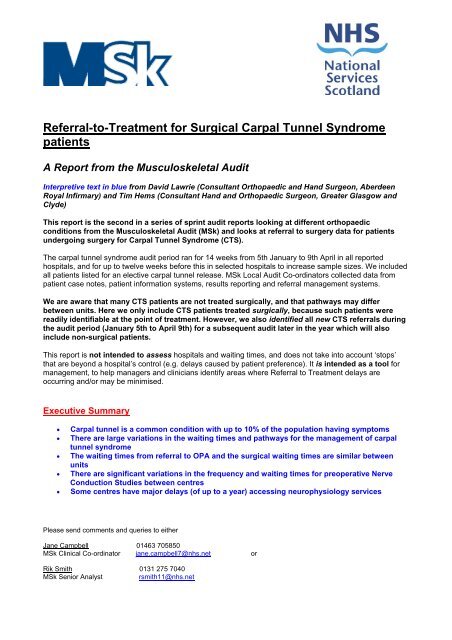
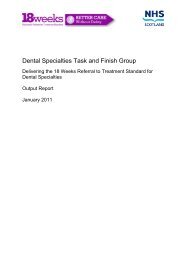
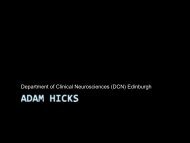
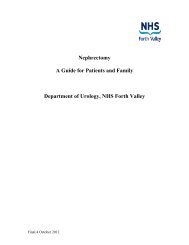
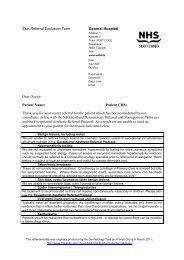
![Dr Matthew Checketts, NHS Tayside [PDF - 6Mb] - 18 Weeks](https://img.yumpu.com/49027155/1/190x143/dr-matthew-checketts-nhs-tayside-pdf-6mb-18-weeks.jpg?quality=85)
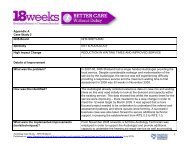
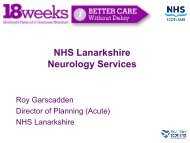
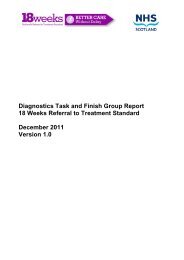

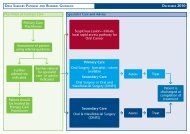

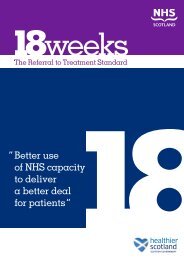
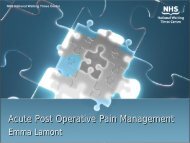
![Mark Sindall, NHS Dumfries and Galloway [PDF - 227Kb] - 18 Weeks](https://img.yumpu.com/30080335/1/190x143/mark-sindall-nhs-dumfries-and-galloway-pdf-227kb-18-weeks.jpg?quality=85)